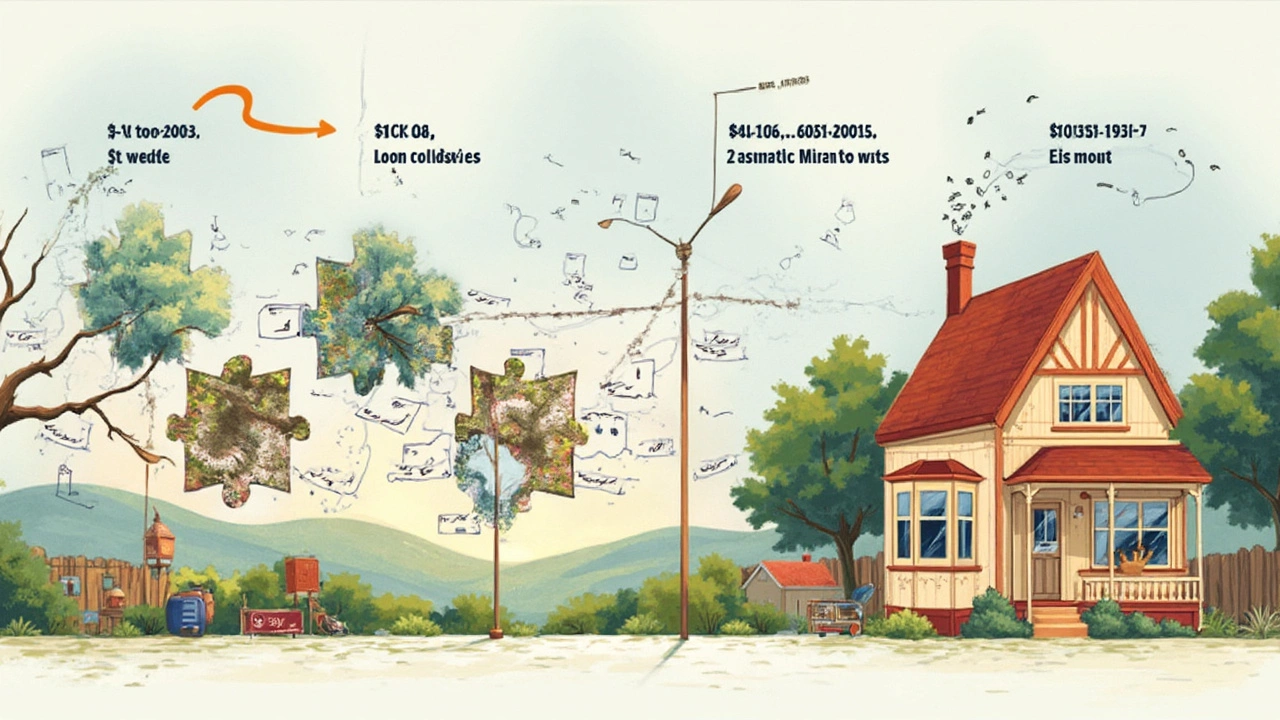How Much Do First-Time Home Buyers Usually Put Down?
 Feb, 15 2025
Feb, 15 2025
Thinking about buying your first home? It’s like stepping into a whole new world. One big question that pops up is how much you should put down as a down payment. Traditionally, everyone talks about that hefty 20%. But, spoiler alert: most first-timers don’t cough up that chunk of change.
Actually, many put down only about 6% to 7%. So, why’s the 20% number out there? It’s the magic number lenders love because it often means avoiding private mortgage insurance (PMI) and snagging better mortgage terms. But hey, no need to panic if 20% isn't within reach. There are a ton of options that can get you into your dream home without breaking the bank.
- Understanding Down Payments
- Common Down Payment Percentages
- Mortgage Options for First-Time Buyers
- Government Assistance Programs
- Tips for Saving Up
Understanding Down Payments
Alright, let’s break it down. A down payment is basically the initial, upfront money you throw in when buying a home. Think of it as the 'skin in the game' that shows you’re serious about this big purchase. Now, while that legendary 20% isn’t mandatory for first-timers, there's a reason why it's often mentioned.
Mortgage lenders love 20% because it reduces their risk. It means you're less likely to bail on the loan, and in return, they might cut you a deal with lower interest rates or waive that pesky PMI. But don't sweat it if you don't have that kind of cash lying around. There are lots of other routes.
The Low-Down on Low Down Payments
Most first-time buyers actually opt for lower down payments, often between 5% to 7%. Why? Because when you're saving up for a home, especially in today’s market, things add up fast – think student loans, car payments, and just life in general.
- FHA Loans: These let you get in with as little as 3.5%, and they’re solid if you’ve got a decent credit score.
- VA Loans: If you’re a veteran, you could snag a home with zero down, thanks to the Department of Veterans Affairs.
- USDA Loans: Looking to skip the city life? USDA loans cover rural areas with no down payment too!
Each option has its pros and cons, so it’s worth chatting with a trusted lender to see what fits your wallet and your plans.
Your down payment choice impacts your monthly bills and overall loan costs. So, while it’s tempting to toss in the minimum, weigh the long-term effects.
Common Down Payment Percentages
Alright, let’s get real about those down payment numbers for a first-time home buyer. The old-school rule preaches a 20% down payment. But honestly, if everyone could slap down 20%, we’d all be in mansions. The truth is, most first-time folks are looking at numbers much lower than that.
According to the National Association of Realtors, the typical down payment for first-time buyers as of 2023 is around 6% to 7%. You heard that right. And it's no secret either. Many banks and mortgage lenders provide low-down payment options specifically tuned for new buyers.
"Most first-time home buyers today are putting well below 20% down," says Lawrence Yun, Chief Economist of the National Association of Realtors. "This is possible thanks to a variety of mortgage programs available today."
So, what's the deal with these smaller percentages? Let’s break it down:
- FHA Loans: These beauties require as little as 3.5% down. They're backed by the Federal Housing Administration, making them a popular choice for first-timers with limited savings.
- Conventional Loans: Some conventional loans allow down payments as low as 3%—perfect if you're trying to keep more of your cash handy.
- VA and USDA Loans: If you’re eligible, these can be solid gold, requiring zero down payment.
Wondering what's the catch with lower down payments? Well, putting less upfront means you’ll probably pay more in interest over time and might have to factor in PMI. But if you're itching to break free from renting, finding that sweet spot for your down payment can make owning a reality faster than you might think.

Mortgage Options for First-Time Buyers
Diving into the world of mortgages can be confusing for first-time buyers. But, understanding your options makes the home-buying journey a lot less daunting. Let’s break it down, starting with the most common types of mortgages you might encounter.
Conventional Loans
These are the go-to choice for many homebuyers. Why? Well, they often come with favorable terms if you can swing a decent credit score. Typically, you’d need a minimum of 3% for a down payment. However, putting down less than 20% might mean having to pay for PMI.
FHA Loans
Backed by the Federal Housing Administration, FHA loans are like a safety net. They’re more lenient with credit scores and debt-to-income ratios, making them perfect for newbies. The gem here is that you can get away with just a 3.5% down payment.
A mortgage expert once said, “FHA loans are an excellent tool for first-time homebuyers with less cash for their down payment.”
USDA Loans
These are a gold mine for those eyeing the rural or suburban areas. Offered by the United States Department of Agriculture, USDA loans require zilch as a down payment. However, your property must be in an eligible area, and there are income limits to consider.
VA Loans
Are you a veteran or currently serving in the military? VA loans could be your jackpot. Offered by the Department of Veterans Affairs, these loans often don’t need a down payment. Plus, no PMI is required, making them a solid choice for those who’ve served.
State and Local Programs
Don’t overlook state and local programs. Many states offer down payment assistance to help with the initial cost hurdle. These can be grants, forgivable loans, or deferred payment loans aimed at giving first-time buyers a leg up.
It’s always good to explore your options and maybe plot out your next steps. Speak with lenders, ask questions, and don’t hesitate to shop around for the best deal. After all, understanding your mortgage options can mean landing the perfect fit for your financial situation.
Government Assistance Programs
When you're a first-time home buyer, government assistance programs can be a real lifesaver. These programs are especially designed to help folks like you get their foot in the door without having to shell out big bucks upfront. Let's dive into some options!
FHA Loans
The Federal Housing Administration (FHA) backs loans that make it easier for first-timers. You can land a mortgage with as little as a 3.5% down payment. That’s right, 3.5%! Plus, the credit score requirements are generally lower, which gives more people a shot at home ownership.
VA Loans
If you’re a veteran, active-duty service member, or eligible family member, the Department of Veterans Affairs (VA) loans might be your best bet. With a VA loan, you could buy a home with no down payment at all. No PMI needed, either! It’s like a thank-you note from Uncle Sam.
USDA Loans
For folks buying in rural areas, the U.S. Department of Agriculture (USDA) has a great deal. USDA loans require no down payment, but you'll have to meet certain income limits and the property must be in a designated rural area. It's perfect if you're aiming for a quieter lifestyle.
State and Local Programs
Don't forget to check out what your state or city might offer. Many local governments have programs providing down payment assistance, reduced interest rates, or even tax credits to first-time home buyers. Each program has its own rules, so it's worth looking into what’s available in your neck of the woods.
If these options sound appealing, start by checking the eligibility requirements. It’s all about finding the right fit for your situation. With a little research, you can save a chunk of change and make buying your first home a lot less overwhelming.

Tips for Saving Up
Saving for a down payment feels like a marathon, but breaking it into sprints can make it doable. Here are some practical tips to speed up the process without feeling overwhelmed.
Set a Budget
Start by mapping out your finances. Look at your income and expenses, and see where you can trim the fat. Cutting back on that daily coffee might seem cliché, but those dollars add up fast! Setting up a dedicated savings account for your home fund can help you track your progress and resist the urge to dip into savings.
Automate Your Savings
One of the simplest hacks to boost your savings is automation. Set it and forget it, you know? Arrange for a portion of your paycheck to be directly deposited into your savings for your future home buying. This way, you're less tempted to spend it.
Earn More on the Side
Think about taking up a side gig or freelance work. Whether it's tutoring, design work, or driving for a rideshare service, the extra cash can make a real difference. Sock away all or part of those earnings for your down payment.
Utilize Cash Windfalls
Unexpected money, like tax refunds or bonuses, are perfect to boost your down payment savings. Instead of splurging on a big purchase, put a large chunk (if not all) into your first-time buyers fund.
Cut Out Big Expenses
It might be time to reassess the necessity of that gym membership or premium TV package. Little sacrifices like these can significantly inflate your savings pile over time. Heck, you might discover cheaper or even free alternatives!
Get Help When You Can
Be sure to look into family assistance or any gift money, as long as it doesn't tighten family ties. Plus, consider employer programs; some companies offer perk-filled schemes for real estate investments.
There you go! Follow these steps, and you’ll be feeling house keys in your hand sooner than you think.